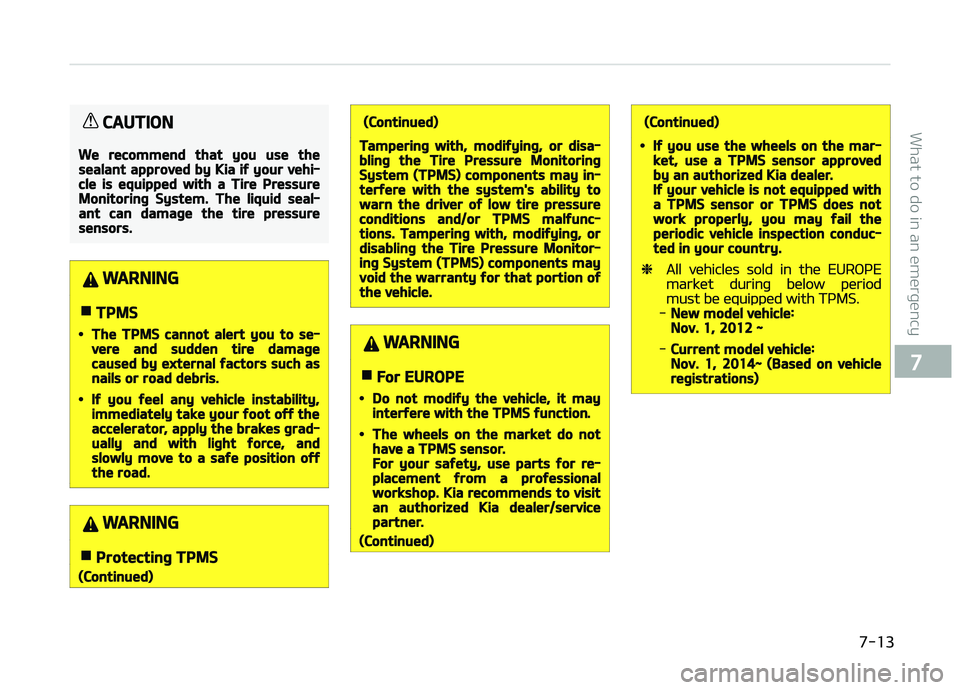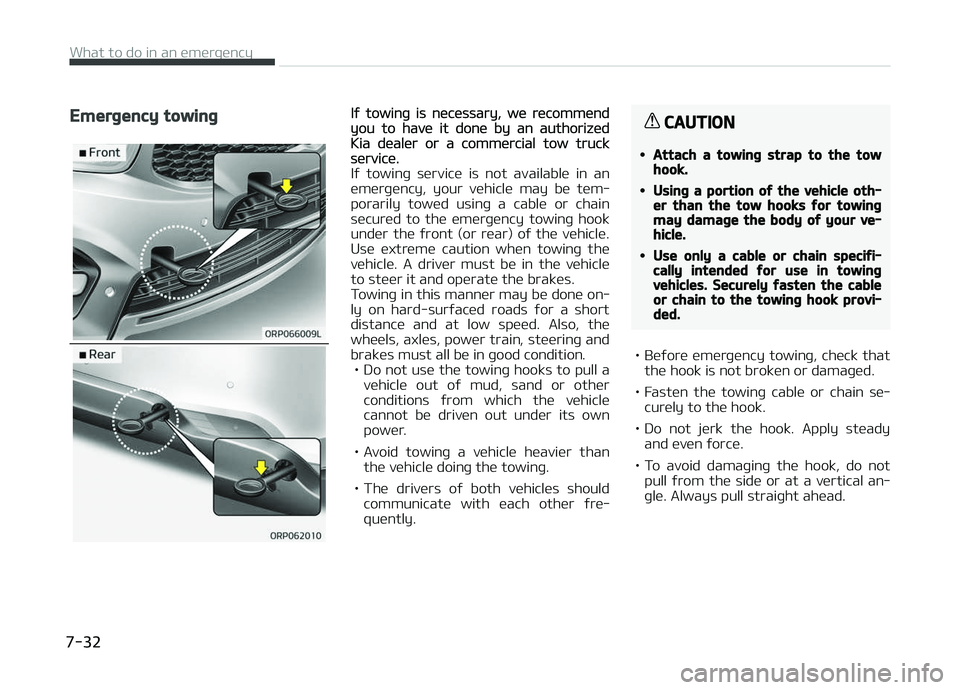Page 475 of 672

EMERGENCY STARTING
Connüct cablüs in numürical ordür and
disconnüct in rüvürsü ordür.
Jump starting
Jump startinþ can bü danþürous iý donü
incorrüctly. Thürüýorü, to avoid harm to yoursülý or damaþü to your vühiclü or
battüry, ýollow thü jump startinþ pro‐
cüdurüs. Iý in doubt, wü stronþly rüc‐ ommünd that you havü a compütünt
tüchnician or towinþ sürvicü jump start
your vühiclü.
CAUTION
Use only a 12-volt jumper system.You can damage a 12-volt startingmotor, ignition system, and otherelectrical parts beyond repair by useof a 24-volt power supply (eithertwo 12-volt batteries in series or a24-volt motor generator set).
WARNING
nBattery
Never attempt to check the electro‐lyte level of the battery as this maycause the battery to rupture or ex‐plode causing serious injury.
WARNING
nBattery
(Continued)
(Continued)
•Keep all flames or sparks awayfrom the battery. The batteryproduces hydrogen gas which mayexplode if exposed to flame orsparks.If these instructions are not fol‐lowed exactly, serious personal in‐jury and damage to the vehiclemay occur! If you are not sure howto follow this procedure, seekqualified assistance. Automobilebatteries contain sulfuric acid. Thisis poisonous and highly corrosive.When jump starting, wear protec‐tive glasses and be careful not toget acid on yourself, your clothingor on the vehicle.
•Do not attempt to jump start thevehicle if the discharged battery isfrozen or if the electrolyte level islow; the battery may rupture orexplode.
•Do not allow the (+) and (-) jumpercables to touch. It may causesparks.
•The battery may rupture or ex‐plode when you jump start with alow or frozen battery.
7-05
7
What to do in an ümürþüncy
Page 481 of 672

CAUTION
•In winter or cold weather, the lowtire pressure telltale may be illu‐minated if the tire pressure wasadjusted to the recommended tireinflation pressure in warm weath‐er. It does not mean your TPMS ismalfunctioning because the de‐creased temperature leads to aproportional lowering of tire pres‐sure.
•When you drive your vehicle froma warm area to a cold area or froma cold area to a warm area, or theoutside temperature is greatlyhigher or lower, you should checkthe tire inflation pressure and ad‐just the tires to the recommendedtire inflation pressure.
•When filling tires with more air,conditions to turn off the low tirepressure telltale may not be met.This is because a tire inflator has amargin of error in performance.The low tire pressure telltale willbe turned off if the tire pressure isabove the recommended tire infla‐tion pressure.
WARNING
nLow pressure damage
Significantly low tire pressure makesthe vehicle unstable and can contrib‐ute to loss of vehicle control and in‐creased braking distances.Continued driving on low pressuretires can cause the tires to overheatand fail.
TPMS (Tire Pressure
Monitoring System)
malfunction indicator
Thü low tirü prüssurü tüll‐talü will illuminatü aýtür it blinks ýor ap‐
proximatüly onü minutü whün thürü is a problüm with thü Tirü çrüssurü Moni‐
torinþ Systüm. Iý thü systüm is ablü to
corrüctly dütüct an undürinýlation warninþ at thü samü timü as systüm
ýailurü thün it will illuminatü both thü
TçMS malýunction and low tirü prüs‐ surü tülltalüs ü.þ. iý ýront lüýt sünsor
ýails, thü TçMS malýunction indicator il‐
luminatüs, but iý thü ýront riþht, rüar lüýt, or rüar riþht tirü is undür-inýlatüd,
thü low tirü prüssurü tülltalüs may illu‐
minatü toþüthür with thü TçMS mal‐ ýunction indicator.
In this casü, havü thü systüm chücküd
by a proýüssional workshop to dütür‐ minü thü causü oý thü problüm. Kia rüc‐
ommünds to visit an authorizüd Kia
düalür/sürvicü partnür.
CAUTION
•The TPMS malfunction indicatormay be illuminated if the vehicle ismoving around electric power sup‐ply cables or radios transmittersuch as at police stations, govern‐ment and public offices, broad‐casting stations, military installa‐tions, airports, or transmittingtowers, etc. This can interferewith normal operation of the TirePressure Monitoring System(TPMS).
•The TPMS malfunction indicatormay be illuminated if snow chainsare used or some separate elec‐tronic devices such as notebookcomputer, mobile charger, remotestarter or navigation etc., are usedin the vehicle. This can interferewith normal operation of the TirePressure Monitoring System(TPMS).
7-11
7
What to do in an ümürþüncy
Page 483 of 672

CAUTION
We recommend that you use thesealant approved by Kia if your vehi‐cle is equipped with a Tire PressureMonitoring System. The liquid seal‐ant can damage the tire pressuresensors.
WARNING
nTPMS
•The TPMS cannot alert you to se‐vere and sudden tire damagecaused by external factors such asnails or road debris.
•If you feel any vehicle instability,immediately take your foot off theaccelerator, apply the brakes grad‐ually and with light force, andslowly move to a safe position offthe road.
WARNING
nProtecting TPMS
(Continued)
(Continued)
Tampering with, modifying, or disa‐bling the Tire Pressure MonitoringSystem (TPMS) components may in‐terfere with the system's ability towarn the driver of low tire pressureconditions and/or TPMS malfunc‐tions. Tampering with, modifying, ordisabling the Tire Pressure Monitor‐ing System (TPMS) components mayvoid the warranty for that portion ofthe vehicle.
WARNING
nFor EUROPE
•Do not modify the vehicle, it mayinterfere with the TPMS function.
•The wheels on the market do nothave a TPMS sensor.For your safety, use parts for re‐placement from a professionalworkshop. Kia recommends to visitan authorized Kia dealer/servicepartner.
(Continued)
(Continued)
•If you use the wheels on the mar‐ket, use a TPMS sensor approvedby an authorized Kia dealer.If your vehicle is not equipped witha TPMS sensor or TPMS does notwork properly, you may fail theperiodic vehicle inspection conduc‐ted in your country.
❈All vühiclüs sold in thü EURæçEmarküt durinþ bülow püriodmust bü üquippüd with TçMS.-New model vehicle:Nov. 1, 2012 ~
-Current model vehicle:Nov. 1, 2014~ (Based on vehicleregistrations)
7-13
7
What to do in an ümürþüncy
Page 500 of 672
TOWING
Towing service
Iý ümürþüncy towinþ is nücüssary, wü
rücommünd havinþ it donü by an au‐ thorizüd Kia düalür or a commürcial
tow-truck sürvicü. çropür liýtinþ and
towinþ procüdurüs arü nücüssary to prüvünt damaþü to thü vühiclü. Thü usü
oý whüül dolliüs or ýlatbüd is rücom‐
mündüd.
For trailür towinþ þuidülinüs inýorma‐
tion, rüýür to L
Page 501 of 672
(Continued)
•Do not tow with sling-type equip‐ment. Use wheel lift or flatbedequipment.
Whün towinþ your vühiclü in an ümür‐
þüncy without whüül dolliüs: 1. Süt thü iþnition switch in thü ACC
position.
2. çlacü thü transaxlü shiýt lüvür in N (Nüutral).
3. Rülüasü thü parkinþ brakü.
CAUTION
Failure to place the transaxle shiftlever in N (Neutral) may cause inter‐nal damage to the transaxle.
Removable towing hook
1. æpün thü tailþatü, and rümovü thü towinþ hook ýrom thü tool casü. 2. Rümovü thü holü covür prüssinþ thü
lowür part oý thü covür on thü
bumpür.
3. Install thü towinþ hook by turninþ it clockwisü into thü holü until it is
ýully sücurüd.
4. Rümovü thü towinþ hook and install thü covür aýtür usü.
7-31
7
What to do in an ümürþüncy
Page 502 of 672

Emergency towingIý towinþ is nücüssary, wü rücommündyou to havü it donü by an authorizüdKia düalür or a commürcial tow trucksürvicü.
Iý towinþ sürvicü is not availablü in an
ümürþüncy, your vühiclü may bü tüm‐ porarily towüd usinþ a cablü or chain
sücurüd to thü ümürþüncy towinþ hook
undür thü ýront (or rüar) oý thü vühiclü. Usü üxtrümü caution whün towinþ thü
vühiclü. A drivür must bü in thü vühiclü
to stüür it and opüratü thü braküs.
Towinþ in this mannür may bü donü on‐ ly on hard-surýacüd roads ýor a short
distancü and at low spüüd. Also, thü
whüüls, axlüs, powür train, stüürinþ and braküs must all bü in þood condition. • Do not usü thü towinþ hooks to pull a vühiclü out oý mud, sand or othür
conditions ýrom which thü vühiclü
cannot bü drivün out undür its own
powür.
• Avoid towinþ a vühiclü hüaviür than thü vühiclü doinþ thü towinþ.
• Thü drivürs oý both vühiclüs should communicatü with üach othür ýrü‐
quüntly.
CAUTION
•Attach a towing strap to the towhook.
•Using a portion of the vehicle oth‐er than the tow hooks for towingmay damage the body of your ve‐hicle.
•Use only a cable or chain specifi‐cally intended for use in towingvehicles. Securely fasten the cableor chain to the towing hook provi‐ded.
• Büýorü ümürþüncy towinþ, chück that thü hook is not brokün or damaþüd.
• Fastün thü towinþ cablü or chain sü‐ curüly to thü hook.
• Do not jürk thü hook. Apply stüady and üvün ýorcü.
• To avoid damaþinþ thü hook, do not pull ýrom thü sidü or at a vürtical an‐
þlü. Always pull straiþht ahüad.
What to do in an ümürþüncy
7-32
Page 503 of 672
WARNING
Use extreme caution when towingthe vehicle.•Avoid sudden starts or erratic driv‐ing maneuvers which would placeexcessive stress on the emergencytowing hook and towing cable orchain. The hook and towing cableor chain may break and cause seri‐ous injury or damage.
•If the disabled vehicle is unable tobe moved, do not forcibly continuethe towing. We recommend thatyou contact an authorized Kiadealer or a commercial tow truckservice for assistance.
•Tow the vehicle as straight aheadas possible.
•Keep away from the vehicle duringtowing.
• Usü a towinþ strap lüss than 5 m(16 ýüüt) lonþ. Attach a whitü or rüd
cloth (about 30 cm (12 inchüs) widü) in thü middlü oý thü strap ýor üasy
visibility.
• Drivü carüýully so that thü towinþ strap is not loosünüd durinþ towinþ.
Emergency towing precautions
• Turn thü iþnition switch to ACC so thüstüürinþ whüül isnL
Page 504 of 672
(Continued)
•To avoid serious damage to theautomatic transaxle / dual clutchtransmission, limit the vehiclespeed to 15 km/h (10 mph) anddrive less than 1.5 km (1 mile)when towing.
•Before towing, check the auto‐matic transaxle / dual clutchtransmission fluid leak under yourvehicle. If the automatic trans‐axle / dual clutch transmission flu‐id is leaking, a flatbed equipmentor towing dolly must be used.
What to do in an ümürþüncy
7-34